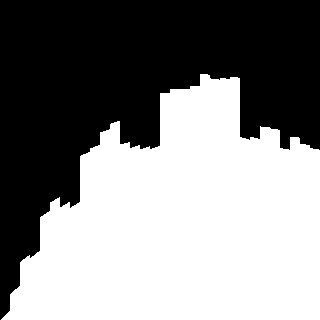Workshop GLSL - Noise - Chapter 6.5 - Perlin 1D

Explanations
Now let’s implements Perlin 1D
#define PROCESSING_COLOR_SHADER
uniform float time;
uniform vec2 resolution;
float rand(float x){
return fract(sin(x * 12.9898) * 43758.5453);
}
float noise(float x, float frequency)
{
float v = x * frequency;
float ix1 = floor(v);
float ix2 = floor(v + 1.0);
float fx = fract(x);
return mix(rand(ix1), rand(ix2), fx);
}
Our Perlin Noise 1D version.
float pnoise(float x, float freq, int steps, float persistence)
{
float value = 0.0;
float ampl = 1.0;
float sum = 0.0;
for(int i=0 ; i<steps ; i++)
{
sum += ampl;
value += noise(x, freq) * ampl;
freq *= 2.0;
ampl *= persistence;
}
return value / sum;
}
void main( void ) {
vec2 position = gl_FragCoord.xy / resolution.xy;
Test it with classic 0.5 persistence and 4 fractal levels
float y = pnoise(position.x + time * 0.1, 2.0, 5, 0.6);
float v = step(position.y, y);
gl_FragColor = vec4(v,v,v,1.0);
}
we see multiple fractal levels added together giving a squared mountains
Full Code Source
#define PROCESSING_COLOR_SHADER
uniform float time;
uniform vec2 resolution;
float rand(float x){
return fract(sin(x * 12.9898) * 43758.5453);
}
float noise(float x, float frequency)
{
float v = x * frequency;
float ix1 = floor(v);
float ix2 = floor(v + 1.0);
float fx = fract(x);
return mix(rand(ix1), rand(ix2), fx);
}
float pnoise(float x, float freq, int steps, float persistence)
{
float value = 0.0;
float ampl = 1.0;
float sum = 0.0;
for(int i=0 ; i<steps ; i++)
{
sum += ampl;
value += noise(x, freq) * ampl;
freq *= 2.0;
ampl *= persistence;
}
return value / sum;
}
void main( void ) {
vec2 position = gl_FragCoord.xy / resolution.xy;
float y = pnoise(position.x + time * 0.1, 2.0, 5, 0.6);
float v = step(position.y, y);
gl_FragColor = vec4(v,v,v,1.0);
}



